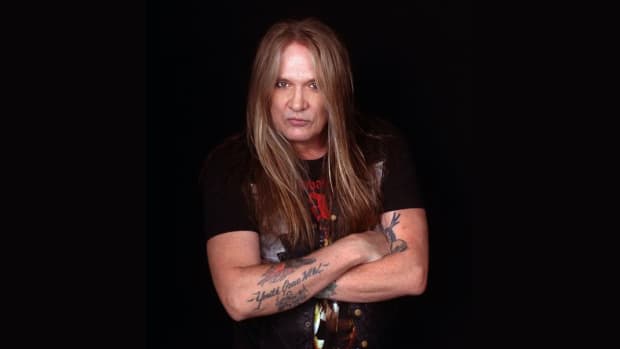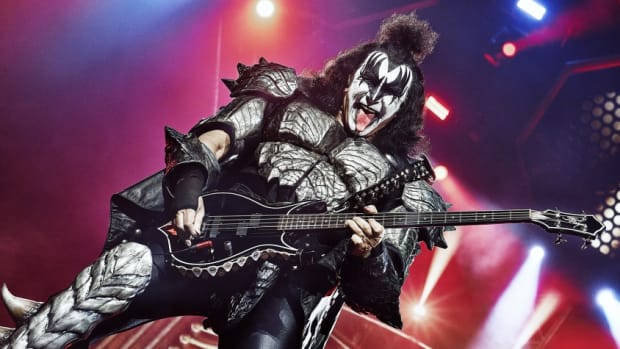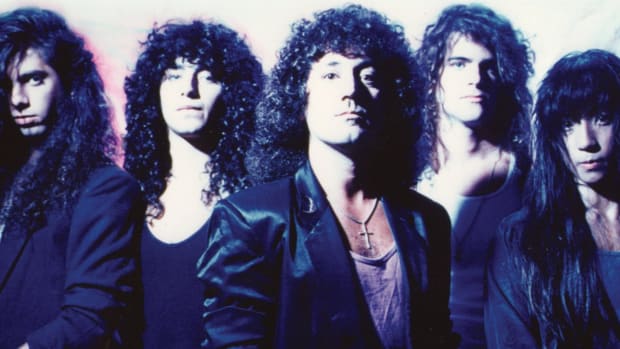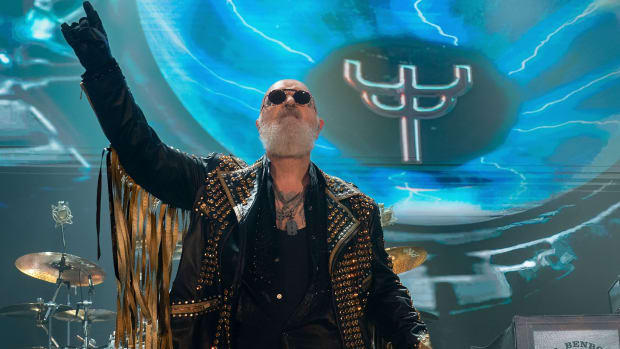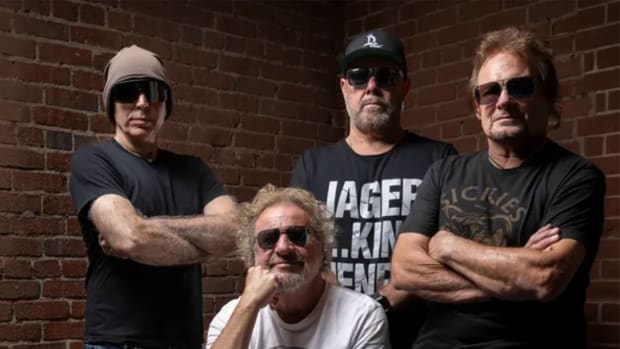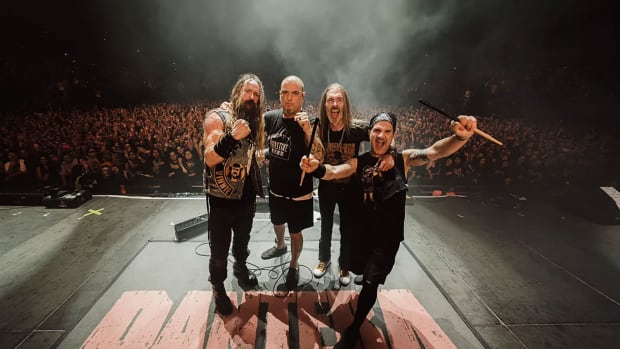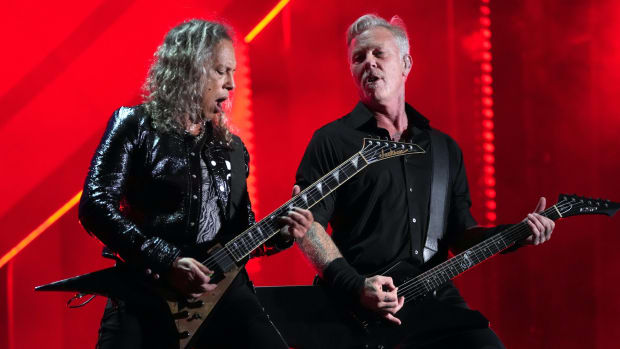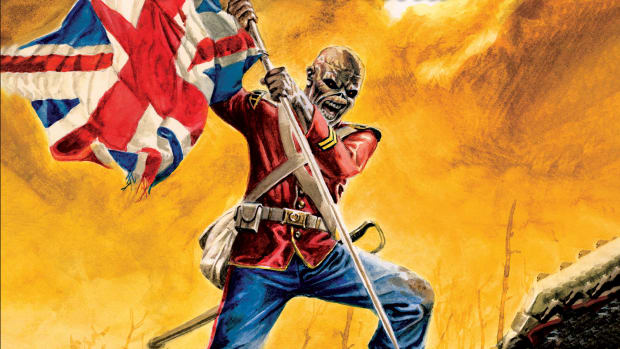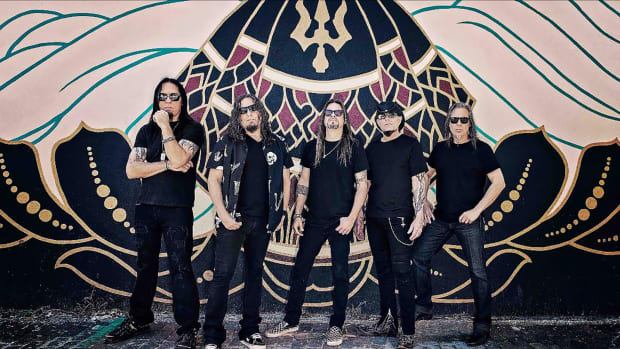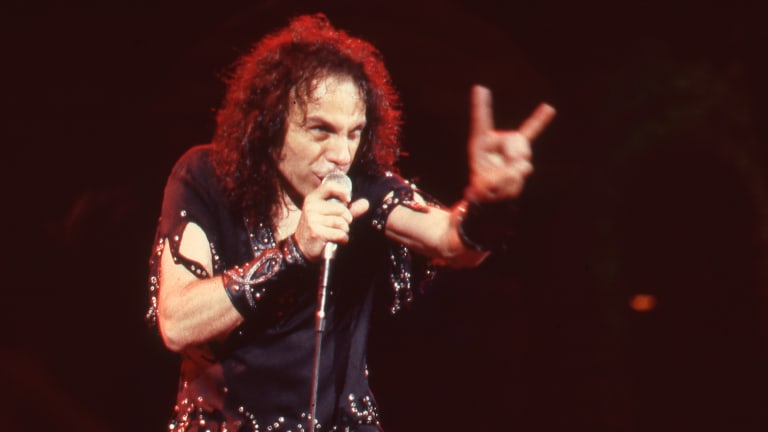
'From ’50s doo-wop crooner to heavy-metal legend': The ultimate Ronnie James Dio story
How did a ’50s doo-wop crooner end up an ’80s heavy-metal legend onstage in arenas with a laser-sword and animatronic dragon? ‘Tis an epic tale. And Dio: Dreamers Never Die, the inspiring new documentary film about the late great Ronnie James Dio, tells it well.
Dio is known as the powerful voice and fantastical pen behind metal classics like Black Sabbath’s “Heaven and Hell,” Rainbow’s “Man on the Silver Mountain” and his namesake band’s “Holy Diver.” Not to mention the originator of the devil-horns hand gesture now ubiquitous everywhere from the stage to selfies. Dio endured decades of career tribulations to give us that music. He never gave up though. And he never comprised, as Dreamers Never Die lays out in its seamless 127-minutes.
Directed by Don Argott and Demian Fenton, the filmmakers behind acclaimed docs on subjects ranging from Pentagram to John DeLorean, Dreamers weaves together archival footage, new interviews and cinematic reenactments into a tapestry of Dio’s musical life. In addition to commentary from Dio’s former bandmates, including Sabbath’s Tony Iommi, Geezer Butler and Bill Ward, colleagues like Lita Ford, Rudy Sarzo and Glenn Hughes and superfans like Sebastian Bach and Jack Black and hometown friends provide nuanced and passionate insights.
“Ronnie's story is very unique,” Argott tells Metal Edge, “in that it does not fall into any of the archetypical stories of sex, drugs and rock ‘n’ roll, crashing and burning, all that kind of stuff. He's really on this kind of rollercoaster ride.”
After a run on the film festival circuit and a Hollywood screening, Dreamers Never Die came to cinemas worldwide Sept. 28 and Oct. 2. The intent of the limited theatrical run was to provide Dio fans with a communal experience echoing the special bond metal fans felt together at Dio’s concerts. “We all know from growing up listening to this music,” says Argott, whose fave rock docs include Gimme Shelter and Some Kind of Monster, “when you find your people that all love the same things, it's a special thing.” You can view updates on future festival screenings and streaming, Blu-ray and DVD releases at diodreamersneverdie.com.
Dio’s musical story begins in small town upstate New York as a child, learning how to play trumpet, an instrument that informed his powerful vocal technique later, and then bass guitar. His trajectory steepened when he and his bandmates in early ’70s boogie-rock combo Elf were selected by Deep Purple to record for Purple’s vanity label and tour with the “Smoke on the Water” stars. Things steepened even more when mercurial Deep Purple guitar god Ritchie Blackmore poached Elf to be Blackmore’s band for his new project, Rainbow. The Holy Trinity of heavy-rock bands – Purple, Sabbath and Led Zeppelin – all drew heavily from the blues. But Rainbow introduced a more neoclassical side to loudness.
“That was the band that I wanted to be in forever,” Dio says of Rainbow, in a vintage audio interview excerpted in Dreamers Never Die. “That was my chance to do what I was born to do, just write classically-oriented fantasy kind of music.” And so he did, as heard on mystical-metal-marvels like the 1976 classic, “Stargazer.”
Rainbow was big in Europe and Japan but never broke through in the crucial U.S. market. Blackmore got itchy for a U.S. radio hit and wanted to record the catchy love song “Since You’ve Been Gone.” Disinterested in playing the pop game after chasing pre-Beatles hits early his career, Dio left the band with little money. Rainbow soon scored a smash with Graham Bonnet singing “Since You’ve Been Gone.”
But Dio departed with a crucial ally and love: wife Wendy Dio, a savvy and striking part-time actress he’d met while she was working at Hollywood’s infamous Rainbow Bar & Grill. “He was so interesting and such a wonderful person,” Wendy says in the doc. “I fell in love with his brain actually and the way he was, his graciousness.”
Another fortuitous Rainbow (Bar & Grill) connection: meeting Sabbath guitarist Tony Iommi, which led to Dio fronting Black Sabbath after the “Paranoid” hitmakers parted ways with original throat Ozzy Osbourne. By the end of the ’70s, Sabbath was adrift creatively. On their ’78 tour, they’d been routinely blown off the stage by their opening act, an energetic California hard-rock band named Van Halen.
Still, as Dreamers Never Die depicts, an Ozzy-less Sabbath was an unsure bet. But Iommi, bassist Geezer Butler and drummer Bill Ward were energized by Dio and together they made Heaven and Hell, a propulsive platinum-selling album. (Osbourne made out okay too - his debut LP, Blizzard of Ozz, is a millions-selling metal must-have.) Sabbath’s next album with Dio, Mob Rules, was another blistering LP with another golden title-track. But during the mixing of concert disc Live Evil, Dio and Iommi had a falling out. The singer exited Sabbath. This marked the second straight project with A-list stars that soured quickly for him.
At this point, Wendy became Ronnie’s manager. Even when things changed for them romantically, they remained devoted partners in Ronnie James Dio Inc. “We were a team,” Wendy Dio tells Metal Edge. “Obviously, we had arguments and disagreements and different things. But the main thing was I never interfered with Ronnie's music, and he never interfered with my business. And so we worked together for the same ultimate goal, and that was Ronnie's music.”
Now in his early 40s, Dio formed a new band under his own name, which also included latter-day Sabbath drummer Vinnie Appice, Rising-era Rainbow bassist Jimmy Bain and 19-year-old Irish guitar phenom Vivian Campbell. The newly-formed quartet set up camp at Sound City, the shaggy Los Angeles studio where then-recent hit Tom Petty albums had been recorded. Fueled by weed and candy bars, the Dio band recorded their powerhouse 1983 debut album Holy Diver, which boasted soon-to-be essentials like “Rainbow in the Dark,” “Stand Up and Shout” and the fist-pumping title track.
Back then, pre-internet/pre-streaming, album covers were often the way young rock fans found a new album to purchase at the record store, as rock-radio personality Eddie Trunk notes in Dreamers Never Die’s opening segment. One of the film’s coolest nonmusical moments occurs later in the doc, when the story is told of how Holy Diver’s now-iconic cover art, depicting a drowning priest ensnared by a demon’s chains, was conceptualized and created.
The large scale original Holy Diver painting, by Randy Berrett, currently hangs above the desk in Wendy Dio’s office. “I won’t part with that for anything,” Wendy tells Metal Edge. Argott and Fenton worked on Dreamers Never Die for three years, a timeline extended by the pandemic. Wendy provided the filmmakers with total access to her extensive mementos from Ronnie’s career.
She gave them carte blanche as far as the documentary went, except for one request: Wendy insisted on the inclusion of “Love Is All,” the Dio-sung novelty from The Butterfly Ball and the Grasshopper's Feast, a curio mid ’70s concept album by Deep Purple/Rainbow bassist Roger Glover inspired by a children’s poem. “That was important,” Wendy says, “because that the first gold record Ronnie ever received.”
Back when Argott was a teenager growing up in the Northeast, he got into Dio’s music through the Heaven and Hell album, then the Dio records. Argott says listening to metal and punk music as a teen, “put me on a path of things that I was interested in, and that's frankly why I'm doing what I do as a filmmaker. Ronnie's message of believing in yourself and chasing your dreams, I'm living proof of it. In this incredible full-circle moment, now I get to make a film that celebrates Ronnie's life and legacy. It's really hard for me to process it all, to be honest.” In addition to making films together, Argott and Fenton both play guitar in Serpent Throne, a band specializing in Sabbath-hued instrumentals.
Holy Diver went platinum, as did 1984’s sophomore Dio album, The Last in Line, which was anchored by another stirring title track. The band’s third LP, Sacred Heart, went gold. Dio was headlining arenas, and performing upon that gloriously over-the-top dragon-and-lasers adorned stage set. Decades into a career in which he’d often been a replacement singer or second fiddle to an established star, Dio finally made it in a band with his name on it.
“I remember bumping into him on that tour,” recalls rock journalist Mick Wall, who completed Dio’s unfinished memoir, in Dreamers Never Die. “I’d never seen him so full of joy. I’d never seen him so fulfilled. He knew I think that he’d done something remarkable with his career at this point, but it’d taken Ronnie maybe 40 years to get there. And Ronnie slaying the dragon [onstage] becomes a metaphor for the man. His whole life had been a battle.”
Wendy reflects on this triumphant era in a Dreamers scene where she’s flipping through vintage Sabbath and Dio press clippings. “It was a great time in our lives,” she says in the doc. She tells Metal Edge some of her favorite documentary moments Argott and Fenton turned up, include Appice finding a cassette of an early Dio rehearsal he didn’t recall having. When Appice plays the tape, it’s startling how supernaturally powerful Ronnie’s vocals sound, even in a room with cranked amps and crashing drums.
Unfortunately, the original Dio band began fracturing. “We had a lot of fun on the first two records,” Campbell says in the doc. “By the time we were doing the Sacred Heart album, that was a very dark record for us to make.” Appice adds, “The business end of this started getting really frustrating and Viv was the one who would point it out.” The rift was because, Campbell says in the doc, “the promise was made to us that by the third album it would be more of an equitable situation.”
Dio’s perspective was that a young guitarist he put on the map was making a leverage play. In an archival interview, Dio counters that Campbell didn’t bring new material to the Sacred Heart sessions. “Money is not what music is all about,” Dio says in the doc. Wendy adds in the film, “The band was called Dio for a reason.” This time, it was Dio’s turn to be the Blackmore- or Iommi-type CEO. Dio cut Campbell loose; the guitarist went on to join Whitesnake and, later, Def Leppard.
Dio soldiered on, bringing in another young guitar hotshot, Craig Goldy, who Ronnie had previously worked with in Hear ‘n Aid, the Ronnie-led metal charity that recorded the single “Stars,” and Rough Cutt, a band Ronnie had produced demos for.
Metal was thriving commercially, with newer bands like Mötley Crüe, Ratt and Skid Row crossing over into pop. But the next wave of acts seemed to be increasingly more about looks than music,, with lyrics focused on partying and sex. Metal went from leather to pastels. You know what happened next. In the early ’90s, bands like Nirvana and Alice in Chains, who played a grittier form of heavy rock soon dubbed grunge, emerged, making glam-metal groups sound and look flimsy by comparison.
Pop-culture history tends to focus on Sunset Strip pretty boys getting toppled by grunge. But it was also authentic metal bands like Dio. “The music was rubbish,” Dio says of more superifical late ’80s rock bands, in an archival interview in Dreamers Never Die. “And they destroyed what the rest of us created.” He adds, “And MTV, which was built on heavy metal music, suddenly went, ‘No more of that.’ ”
In Dreamers Never Die, Eddie Trunk tells a poignant story about his rock-radio station program director instructing him to put all their ’80s-band CDs in a cardboard box and play only grunge and alternative bands instead. Even metal lords like Judas Priest, Iron Maiden and Black Sabbath, who Ronnie had reunited with for the 1991 album Dehumanizer, suffered this fate. “All of this goes away, and all of this is suddenly uncool,” Trunk says. “It was like that, cut and dry. Dio was in the box [of discarded CDs].”
Dio got dropped by his major-label and was back to performing in club-level venues. Rock media now fixated on alt-rock and nu-metal bands and no interest in classic-metal musicians like Ronnie James Dio. Such an unjust fall would’ve downward-spiraled lesser men. “That was a really down time for him,” Wendy says in the documentary. “He didn’t feel loved anymore.” The doc doesn’t get into this, but the fact that one of grunge’s most famous singers, Soundgarden’s Chris Cornell, bore more than a passing vocal resemblance to Ronnie’s singing style had to have made Dio’s ’90s downturn sting even worse.
Still, Dio soldiered on, making new albums and slogging out gigs. “Through the hard times, love what you do,” Dio says in the doc. Nineties footage of the still strong-voiced singer belting out “Last In Line” to a smattering of applause in a club is both inspiring and heartbreaking.
“It really was this kind of sad moment,” Argott says of Dio’s ’90s nadir. “But to me, it illustrates, like everything, what Ronnie is about. Ronnie didn't change. He didn't start making grunge music. He didn't start trying to chase trends and I think that's what's beautiful about it. Because it's all going to come back around again. And when it comes back around, are you going to have your integrity intact?”
The focus on Dreamers Never Die is Dio’s career, although there’s endearing footage of Ronnie and Wendy’s verdant, hilly Los Angeles area property and gothic-decorated home. Interestingly, Wendy tells Metal Edge that Ronnie never sang around the house. “He would sit on the couch with his acoustic guitar and write songs watching sports. Sit around in his Walmart sweats and just, you know, be a normal human being. He was a big rock star onstage and he was very humble at home. He liked having his friends around having drinks and stuff and playing with his animals and watching sports. That was just his normal life when he was off the road.” When they were home, Wendy tells Metal Edge Ronnie would listen to music ranging from Deep Purple to Beethoven. And he was a fan of newer bands too, including Tool and the Darkness.
The last Dio album was 2004’s Master of the Moon, but soon the singer’s past would bring him a better future. Between Black Sabbath reunion projects with Osbourne, Iommi and Butler connected with Dio and Appice again to tour and record under the band name Heaven & Hell. In addition to a couple of major tours, the quartet cut new material for a Dio-era Sabbath compilation and the excellent Heaven & Hell album, 2009’s The Devil You Know. That LP, the last full project Dio recorded, features the standout track “Bible Black.” In Dreamers Never Die, classic-era Skid Row singer Sebastian Bach asserts “Bible Black” was Dio’s best-ever song. “How many artists can say that their last single was among the best? To me, it’s the best. I love that song.” It’s also one of Wendy’s favorites from Ronnie’s catalog, along with “Stargazer,” “Gates of Babylon” and the bluesy Elf obscurity “Hoochie Koochie Lady.”
Wendy Dio tells Metal Edge, “I think the happiest times he had were when he was working with the Sabs, He loved playing with them because they’re such amazing musicians, and I'm so glad he got to go back to them before he passed away. I mean, it doesn't get much better than Tony Iommi, Geezer Butler and Vinnie Appice and they all played so well together, and they were all having such a good time.”
Footage in Dreamers Never Die of a Heaven & Hell photoshoot even shows the normally stone-faced Iommi smiling. “This was exactly the way it was supposed to be,” Dio tells Trunk in a video interview excerpted in the doc. “Heaven & Hell has made a great difference in my attitude as a human being now.” Iommi adds in a new interview for Dreamers, “We’d gone through a lot together over the years and you get to appreciate things sometimes you can’t see when you’re involved in it, but later on you go, ‘That was great.’ ” Butler says in the doc, “You realize you don’t get these kinds of friendships. Really good strong friendships are so hard to get.” As Wendy puts it to Metal Edge, “It was like full circle. It was almost like in his life, he had certain things he had to do. And that was one of the last things he had to do. And then it was time for him to leave.”
Back on top again, Dio learned he had stomach cancer. As devastating as the news was to him, he was the one who ended up comforting Wendy and close friends like Trunk. During his cancer battle, Dio lost sight in one of his eyes and his hands would shake, but he never lost his voice. After some experimental drug treatments, his eyesight returned, the tremors ceased and his tumor reportedly shrank. The singer rallied to appear at the 2010 Golden Gods Awards to receive a best-vocalist honor to chants of “Dio! Dio! Dio!” “That was the night that we thought this is it, he’s back,” Wendy recalls in Dreamers. Unfortunately, yet another Dio comeback wasn’t in the cards.
Ronnie James Dio died May 16, 2010, at age 67. But he’ll live forever in the hearts and souls of fans, friends and colleagues who love him and his transportive music. And now, by delivering the nuggets fans desire but also a compelling arc that stands on its own, Dreamers Never Die will introduce Dio to a new generation and an audience beyond metalheads. Argott says, “Maybe they'll get it now, what we were all about all these years when they looked at us a certain way, the way we dressed. When you see Ronnie's story and you see what his message is, it's like, yeah, we should all be living like Ronnie James Dio.”
Eventually the doc will make its way to streaming services, DVD and Blu-ray. Wendy is in talks with Rhino Records for a four-LP vinyl Dreamers Never Die soundtrack that would traverse from pre-fame recordings, like the 1961 Ronnie Dio and the Redcaps single, “An Angel is Missing,” through his entire career. “We're digging through the vault finding even more gems,” Wendy tells Metal Edge. Future archival Dio releases will include live recordings from 1983 and 1987, she says. “There's a lot of things we're working on. My lot in life is to keep Ronnie’s music and his memory alive, but I'm very protective of his stuff and so it has to be done tastefully.” Dreamers Never Die certainly hits that mark.
Wendy also continues to work with her nonprofit, the Ronnie James Dio Stand Up and Shout Cancer Fund, which has raised more than $2 million so far to support research and education that furthers early detection, prevention and treatment of prostate, colon and stomach cancers. More info at diocancerfund.org.
Wendy is understandably moved by what Argott and Fenton put into Dreamers Never Die. “It was a very bittersweet, emotional ride for me,” she says. “They went above and beyond what I wanted.” So what would Ronnie himself think about this move about his life? “I think he would laugh and chuckle about things in it,” Wendy says. “He was a very humble person, but I think he would have been very pleased with what they did. I'm very proud of the film and I think that Ronnie would be proud of it, too.”
